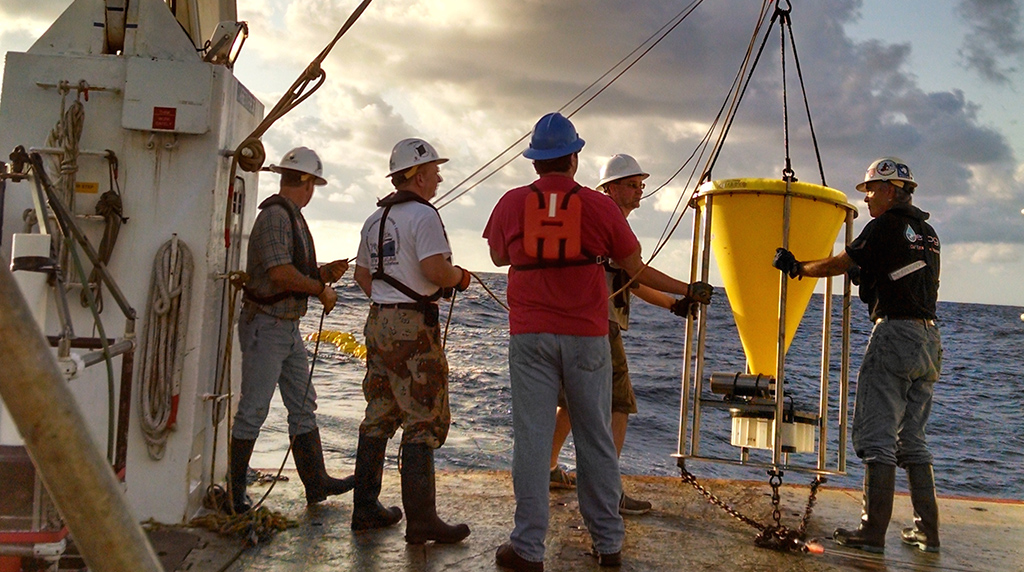April 26, 2015
The Gulf is in serious trouble. As a marine ecosystem, there were many stressors prior to the Deepwater Horizon discharge and there has been little relief in the post-discharge era. For example, the nutrient loading from Mississippi River has continued. Apalachicola Bay, previously a major producer of oysters, has been devastated by diversion of freshwater upstream. Populations of fish, turtles, and marine mammals were seriously depleted. The discharged oil added a sudden, acute stress to an already unstable system. More research is needed to assess recovery, but much of the proposed work is too narrowly focused and basic research assets--ships, instruments, ROVs have limited availability and high costs." In the words of Ian MacDonald, ECOGIG co-principal investigator, there is still a lot more work needed to understand the Gulf's recovery. Today we continue our 3 part series in honor of the 5th anniversary of the April 2010 Deepwater Horizon oil spill. Part 2 has been split into 2 sections - A and B. We asked the ECOGIG investigators for their perspectives on their work since the Deepwater Horizon oil spill.
 Beth Orcutt, Co-PI, Microbiology, Bigelow Laboratory for Ocean Sciences
Beth Orcutt, Co-PI, Microbiology, Bigelow Laboratory for Ocean Sciences
 Laura Lapham, Co-PI, Chemical Oceanography, Univ. of Maryland
Laura Lapham, Co-PI, Chemical Oceanography, Univ. of Maryland
As part of the MIMOSA team, we (Beth and Laura) are advancing the understanding of how oil degrades in the deep sea, using novel benthic experimentation. With these one-of-a-kind experiments, we are getting the first ever estimates of the rate that oil degrades at the bottom of the Gulf, and able to determine the environmental factors that limit its degradation.What is your most significant contribution to advancing DWH science?
Before DWH, we knew that microbes helped break down oil in a complicated way, but most of the research was focused on aerobic processes because they are thought to be the most rapid reactions. Work done by ECOGIG collaborators in the Gulf (mainly the Joye group) before the DWH oil spill, we began to get a sense of the importance of anaerobic processes in breaking down this oil at natural oil and gas seeps. But we still didn't what the in situ rates of oil breakdown were in marine sediments because all the rate assays were done ex situ. Through the ECOGIG program, we have begun to determine how much oil was deposited to the sediments, and we know now that this was a significant amount. Team MIMOSA has developed the technology to now be able to conduct in situ oil/dispersant/oil snow degradation experiments at the seafloor under in situ conditions. These experiments will fundamentally advance the knowledge of oil degradation at cold seeps.
What do you know now about this ecosystem, based on your Deepwater Horizon-based work? Any newly developed methods, scientific communication, etc. that you didn't know 5 years ago?
What we wanted to do with the MIMOSA was extremely challenging, in terms of engineering and developing new technology. We’ve learned firsthand the key importance of having “eyes on the seafloor”. Ocean exploration still is still in its infancy, and though we have access to sophisticated human occupied and remotely operated vehicles, we need to continue to push this technology forward so that we can employ the in situ measurement technology we are developing. As far as science goes, we’ve learnt that methanogens might play a key role in oil degradation at natural seeps, and in places impacted by an oil spill.
 Jennifer Field, Co-PI, Ecotoxicology, Oregon State University
Jennifer Field, Co-PI, Ecotoxicology, Oregon State University
What is your most significant contribution to advancing DWH science?
We created quantitative analytical methods for the quantification of the four surfactant classes in the Corexit oil dispersant (dioctylsulfosuccinate or DOSS, Tween 80, Tween 85, and Span 80) and one degradation product of DOSS (ethylhexylsulfosuccinate or EHSS) in seawater and for DOSS in deep ocean sediment and marine snow. High quality analytical standards were synthesized that make it possible to quantify EHSS, a DOSS biodegradation product, in seawater and laboratory microcosms. With this analytical methodology and high quality standards, we have contributed to the understanding of DOSS occurrence and biodegradation in the Gulf ecosystem.
What is the 'story' told by your research?
At the onset of the Gulf oil spill, the composition of oil dispersant, Corexit, was not known and analytical methods did not exist for the surfactant components of the oil dispersant, Corexit. Development of analytical methods for Gulf seawater, sediments, and marine snow has enabled detailed investigations into the persistence and biodegradation of DOSS in the Gulf. While not persistent in the water column, the main anionic surfactant, DOSS, is persistent in deep ocean sediments up to 3 years after the Gulf oil spill. DOSS is more persistent in aerobic laboratory microcosms containing Gulf microbial communities than previously thought and is not readily (abiotically) hydrolyzed by seawater as previously reported. The mass balance of DOSS in microcosms is not closed, indicating that biodegradation intermediates other than EHSS are formed but they have yet to be identified.
What do you know now about this ecosystem, based on your DWH-based work, newly developed methods, scientific communication, etc. that you didn't know 5 years ago?
DOSS is persistent in Gulf sediments and its long-term fate remains unknown. A DOSS-like, naturally-occurring interference was identified in marine snow, which must be taken into account to accurately quantify DOSS in marine snow and Gulf sediments. The microbial consortia naturally present in the Gulf do not readily biodegrade DOSS under conditions simulating a deep water plume, while the nonionic Tweens and Span surfactant classes are readily removed from test microcosms. DOSS does not readily hydrolyze under marine water conditions as previously reported.
 Ian MacDonald, Co-PI, Remote Sensing, Florida State University
Ian MacDonald, Co-PI, Remote Sensing, Florida State University
What are your most significant contributions to advancing DWH science?
We had two unexpected findings. First was the discovery of injured corals – sea fans – in the mesophotic zone of the northeastern Gulf shelf--depths of 60-90m. The pathology of injury was similar to what other ECOGIG PIs have seen in deep-sea corals at 1200-1600m. However, if oil exposure was the cause of these injuries, the transport pathway must have been the ocean surface, not a deepwater plume.
The second finding was being able to see differences in the distribution and magnitude of surface oil over the course of the DWH discharge with use of satellite synthetic aperture radar. It appears that the responders were able to reduce the volume of oil on the surface by about 20% toward the end of the emergency in June 2010. However, over comparable periods, the ocean area that the remaining oil covered increased by about 50%. We think that the proximal cause of this change was application of dispersants--subsea and aerially--as well as burning of the thickest oil.
How's the Gulf doing in your opinion? Can you make any generalizations yet about whether/how this ecosystem is recovering?
The Gulf is in serious trouble. As a marine ecosystem, there were many stressors prior to the DWH discharge and there has been little relief in the post-discharge era. For example, the nutrient loading from Mississippi River has continued. Apalachicola Bay, previously a major producer of oysters, has been devastated by diversion of freshwater upstream. Populations of fish, turtles, and marine mammals were seriously depleted. The discharged added a sudden, acute stress to an already unstable system. More research is needed to assess recovery, but much of the proposed work is too narrowly focused and basic research assets--ships, instruments, ROVs have limited availability and high costs.
 Barbara MacGregor, Co-PI, Microbiology/Molecular Biology, UNC-Chapel Hill
Barbara MacGregor, Co-PI, Microbiology/Molecular Biology, UNC-Chapel Hill
What is your most significant contribution to advancing DWH science?
The broad ECOGIG collaboration gave us (molecular biologists) access to sediment trap samples that are normally the preserve of geochemists. We have been re-examining assumptions about preservation of material in these traps, which are used to characterize particle transport between surface waters and sediment. This is an important term in marine carbon budgets, and very much affected by oil spills. If material is being altered in the traps, the budget will be thrown out of balance.
What is the 'story' told by your research?
It appears that some level of microbial life and enzymatic activity can persist after mercuric chloride poisoning, especially at deep-water temperatures, as shown by field samples and lab experiments. There is no doubt that mercuric chloride is a poison, but it may not be as universally effective as imagined. The story is still evolving - we hope to determine how significant the suspected preservation issues are, and find ways to minimize them. More broadly, it’s an old story – what seems obvious to a chemist may not be to a biologist, and vice versa, so getting them together is an excellent idea.
 Chris Martens, Co-PI, Chemical Oceanography, UNC-Chapel Hill
Chris Martens, Co-PI, Chemical Oceanography, UNC-Chapel Hill
What is your most significant contribution to advancing DWH science?
The lander team has developed a capability to make critical long-term (up to a year) time-series chemical and physical measurements in the benthic boundary layer (BBL) at any depth in the Gulf. The time-series measurements of light hydrocarbons, ambient dissolved oxygen, current speed and direction, sediment oxygen demand and others are critical because they allow us to determine the sources, transport and fate of light hydrocarbons and oxygen associated with both natural and accidental releases of oil and gas in the Gulf.
What is the 'story' told by your research?
We can view waters in the BBL as huge lenses of water, tens of meters thick, whose chemistry is dramatically influenced by horizontal mixing processes, hydrocarbon releases, microbial responses and sediment water chemical exchanges. Using time-series measurements from sensors on landers we can directly observe those chemical changes as the water lenses slosh past our lander systems with advanced arrays of fast –response sensors.
What do you know now about this ecosystem, based on your Deepwater Horizon-based work? Any newly developed methods, scientific communication, etc. that you didn't know 5 years ago?
We know that light hydrocarbons derived from natural seeps are concentrated in the so-called “friction layer” located approximately between the seafloor and 50 meters up and that we can follow their transport in horizontal plumes for periods of months or longer utilizing our sensor arrays. We have helped develop advanced hydrocarbon sensor systems in collaboration with private sector partner companies that have allowed us to make the first such “methane plume” measurements from a free vehicle in the deep sea. We can also monitor sediment oxygen demand for periods of months to years using a simple open chamber method developed by our group. We are now in position to contribute heavily to both long-term and emergency short-term efforts to trace the fates of hydrocarbon releases and their ecosystem impacts in the deep sea.
Can you make any generalizations yet about whether/how this ecosystem is recovering?
At sites where we are monitoring light hydrocarbons in the friction layer we see only methane from natural seeps. However, we now know that hydrocarbons derived from large accidental releases can be expected to totally overwhelm contributions from natural seeps. For example, around natural seeps we generally find concentrations of ten to 50 nM methane and these concentrations are far below what was observed during and immediately following the DWH blowout or during the Hercules gas rig blowout release.
What was the most surprising discovery?
The sharp focusing of excess methane from natural seeps within the friction layer rather than gradual decline up through the water column as rising gas dissolved was more intense than expected. We also saw fascinating temporal variation in current velocities and associated influences of topography on our chemical and physical measurements.
 Uta Passow, Co-PI, Biological Oceanography, Univ. California Santa Barbara
Uta Passow, Co-PI, Biological Oceanography, Univ. California Santa Barbara
What is your most significant contribution to advancing DWH science?
It is important to understand the fate of the oil released by the spill to assess its influence on ecosystems and marine life. The impact of oil will be different if it floats at the surface than if oil accumulates at the seafloor, for example. We have shown experimentally how oil is incorporated into marine snow, and thus transported to the seafloor. Data from these experiments is combined with analysis of sediment trap samples, which tell us what type of material sank to depths. The analysis of sediment trap data is very complex and still underway. Our work on marine oil snow formation has recently been featured on the GoMRI web page and the GoMRI newsletter (winter 2015 issue) reported on activities of the inter-consortium working group studying the formation and sinking of marine oil snow and its accumulation at the seafloor.
What is the 'story' told by your research?
We think that some fraction of the spilled oil led to the formation of mucus-rich marine snow in some areas, another was incorporated into phytoplankton aggregates, or formed mineral-oil aggregations. All these larger oil containing particles were heavy enough to sink at significant speeds and carry the oil with them to the seafloor, where the marine oil snow impacted corals, fish and other seafloor organisms.
What do you know now about this ecosystem, based on your Deepwater Horizon-based work? Any newly developed methods, scientific communication, etc. that you didn't know 5 years ago?
The idea that significant amounts of oil would sink to the seafloor was not expected at the time of the oil spill in 2010. As the accident unfolded oily contamination was found on the seafloor, which initially many found difficult to believe. Formation of oily marine snow was also observed, but it will take several more years to really understand this process in detail. However, we have come a long way in acknowledging that these pathways that transport oil downward exist, and that there are different types of oil associated marine snow. Which of these mechanisms dominated depends on the specific environmental conditions.
What was the most surprising discovery?
The formation of mucus rich aggregates due to bacteria responding to weathered oil was really unexpected. Large, inch sized particles formed in experiments from seawater that contains no particles, but to which we added oil collected after the spill from the sea surface. The oil associated bacteria used the oil to generate large amounts of mucus, which formed mucus-rich marine snow. This mechanism of large marine snow formation had not been observed before.
 Andreas Teske, Co-PI, Microbiology, UNC at Chapel Hill
Andreas Teske, Co-PI, Microbiology, UNC at Chapel Hill
What are your most significant contributions to advancing DWH science?
The microbial oil degradation cascade in the Gulf of Mexico involves an unexpectedly diverse group of bacteria that were previously not thought to play significant roles in microbial oil degradation. For example, the Roseobacter lineage within the Alphaproteobacteria, the Flavobacteraceae within the Bacteroidetes, and marine members of the Verrucomicrobiaceae are among the early responders to sedimentation of oily marine snow on the seafloor, and they have primary or secondary roles in hydrocarbon degradation that are the subject of current research. Specialized microbial alkane and aromatics degraders are represented as well and we have them in culture, but they dominate specific samples from the early oil spill stages (floating weathered oil at the sea surface in May 2010, the deep hydrocarbon plume in May and June 2010) and they appear as minorities of complex microbial communities observed during later stages of in situ hydrocarbon processing in fall 2010 and thereafter. Interestingly, specialized oil-degrading bacteria do not disappear completely in the aftermath of the blowout, but remain detectable in the marine environment (at low concentrations) by high-throughput sequencing.
What is the 'story' told by your research?
The story starts with desperate dashes to collect sediment, seawater and oil samples during the early oil spill stages (the May and June 2010 cruises), when the true extent of the spill was revised upwards almost daily and the deep hydrocarbon plume was detected and documented for the first time. We did not know it then, but these early samples were absolutely essential to provide the microbiological underpinnings of the “Marine Oil Snowstorm” hypothesis: Rapidly growing oil-containing marine snow flocs were sinking to the seafloor and carrying with them a lot of the DWH-derived hydrocarbons. At the same time, the oily marine snow flocs harbored the primary and secondary oil-degrading bacteria and formed a hot spot of heterotrophic activity. Once oil snow flocs are deposited on the sediment surface and temporarily transform the geochemical regime at the sediment surface, their bacterial communities undergo significant taxonomic changes (monitored during the fall of 2010) as they process the sedimented oil. The PhD thesis of UNC graduate Tingting Yang contains the full story in all its detail. We strongly suspect that specialized degraders of recalcitrant hydrocarbons, such as polyaromatic compounds, remain active today, even if they no longer constitute the dominant microbial community component.
What do you know now about this ecosystem, based on your Deepwater Horizon-based work? Any newly developed methods, scientific communication, etc. that you didn't know 5 years ago?
A major and unexpected find of key importance for the Gulf ecosystem is the formation and role of oil-derived marine snow in oil degradation. Oily marine snow is enriched in specialized petroleum-degrading bacteria; it harbors the oil-associated bacteria that were previously not considered part of the oil spill response, and it shows consistently high activities of heterotrophic degradation. An important ingredient for making oily marine snow, the bacterial production of extracellular polymeric substances (EPS) – the glue that is holding the aggregates together and helps in emulsifying bulk hydrocarbons into smaller particles and droplets – was demonstrated by our collaborator, Tony Gutierrez, in painstaking cultivation work and EPS activity assays for hydrocarbon degradation.
How's the Gulf doing in your opinion? Can you make any generalizations yet about whether/how this ecosystem is recovering? What was your most surprising discovery?
The microbial ecosystem is certainly recovering, or more precisely: reverting to pre-spill conditions, as soon as the microbially accessible petrocarbon compounds are used up. Due to their fast growth, high numbers and ubiquity, microbes are practically indestructible, ride out boom and bust cycles, and adapt easily to a wide range of environmental conditions. Of course, this very optimistic view does not apply (or applies only with major qualifications) to most of the flora and fauna in the Gulf of Mexico; especially slowly growing and maturing deep-sea fauna (think of deep-sea corals) will require decades or even centuries to fully recover. But what is important about the microbial oil spill response is its ubiquity, flexibility and resilience. By natural enrichment of widely different groups of microbes with different substrate spectra and environmental preferences, the microbial oil spill response has processed petrocarbon everywhere - on the sea surface, in the deep water column and on the sediment. This microbial ecosystem response prepares the recovery (or better, is conditional for any recovery) for the rest of the GoM ecosystem. Also, the different tasks of hydrocarbon degradation are probably more widely distributed into different microbial taxa than expected, and a certain degree of functional redundancy could buffer the microbial ecosystem.
Would I be saddened if by some strange microbial ecosystem mishap one of my favorite bacterial oil degraders went extinct? Not really, since its close relatives (related either by descent or by function, or both) would probably recolonize the Gulf of Mexico and ensure that its particular role in the overall Gulf ecosystem would remain filled. [Remember the scene in “Ratatouille” where the rat hero invites his 500 closest rodent relatives into the famed kitchen of Gusteau’s Restaurant? They cook, and get the job done beautifully, to the surprise of the health inspector and the food critic alike.]
 Beizhan Yan, Co-PI, Organic Geochemistry, Columbia University-LDEO
Beizhan Yan, Co-PI, Organic Geochemistry, Columbia University-LDEO
What are your most significant contributions to advancing DWH science?
Analytical methods have been established in my lab to purify and measure hydrocarbons in those highly weathered sediment samples impacted by the Deepwater Horizon oil spill and natural oil seeps. Source apportionment of hydrocarbons has been conducted in GOM water and sediments using source-sensitive indicators to differentiate hydrocarbons from the spill, numerous oil seeps, in-situ burning of crude oil during DWH, and pyrogenic sources from the Mississippi River.
What do you know now about this ecosystem, based on your Deepwater Horizon-based work? Any newly developed methods, scientific communication, etc. that you didn't know 5 years ago?
The surface oil slicks associated with the spill disappeared on the ocean surface in several weeks after the capping of the wellhead; however, water column took much longer to be cleaned and the interactions between oil residues, minerals, and planktons help transport oil components downward to the ocean bottom.
 Kai Ziervogel, co-PI, Biological Oceanographer, UNH
Kai Ziervogel, co-PI, Biological Oceanographer, UNH
 Carol Arnosti, co-PI, Chemical Oceanographer, UNC-Chapel Hill
Carol Arnosti, co-PI, Chemical Oceanographer, UNC-Chapel Hill
What is your most significant contribution to advancing DWH science?
Our laboratory experiments and field observations helped understanding the process of marine oil snow formation and sedimentation as well as associated bacterial activities in the Gulf. Our early work conducted shortly after the onset of the spill showed rapid formation of sinking oil snow in roller bottles filled with a seawater-oil slick mixture from the seasurface near the sunken wellhead. These oil snow aggregates were hotspots for microbial activities redistributing dissolved components of weathered oil throughout the water column during their vertical transport. We also found that sedimented oil snow in the deep GoM can be subject to resuspension affecting distribution of oily particulate matter in GoM deep-sea environments.
What is the 'story' told by your research?
Our discovery of oil snow formation in roller bottles was very surprising for us; we originally wanted to set-up laboratory incubations to monitor bacterial activities in the seawater-oil slick mixture sampled during the first oil spill response cruise. We wanted to create some sort of mixing conditions in the bottles during our incubations to mimic natural conditions at the sea surface. The use of roller bottles seemed appropriate, and shortly after the start of the incubation we saw marine oil snow formation. This work together with research from other groups (U. Passow and M. Joye) formed the basis of the ‘Marine Oil Snow Storm” hypotheses.


















 back to top
back to top